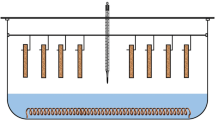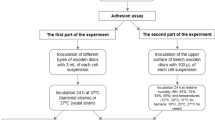Abstract
As direct food contact material, wood is subject to European regulation no. 1935/2004 of 27 October 2004, which specifies that materials intended for safe food contact must not interfere with foodstuff characteristics. In order to comply with this regulation, it is important to provide an efficient recovery method so that the microbial load on wooden surfaces in direct contact with products can be determined. This study compares three methods of recovering microorganisms from wooden packaging surfaces: grinding, brushing, and planing techniques. We chose three microorganism models, at various concentrations, which are well-known risks in the food industry: Escherichia coli (vegetable sector), Listeria monocytogenes (dairy sector), and Penicillium expansum (fruit sector). Tests were carried out on three types of wooden surface, either dry or wet, and made of poplar, Scots pine, and spruce, which are commonly used in France for wooden packaging in the food industry. We identified which factors influenced microorganism recovery rates: wood moisture content, contact time, and wooden species. The grinding technique was the one which delivered the best recovery yield with an average of 30.1 % for L. monocytogenes on spruce and E. coli on poplar and 30.4 % for P. expansum on poplar at 37 % of wood moisture content. Planing method was also chosen to be applied to thicker wooden samples. These most reliable recovery methods will be used as a basis for the development of a specific standard to assess the food safety of wooden packaging.




Similar content being viewed by others
References
Abrishami SH, Tall BD, Bruursema TJ, Epstein PS, Shah DB (1994) Bacterial adherence and viability on cutting board surfaces. J Food Saf 14(2):153–172
Ak NO, Cliver DO, Kaspar CW (1994a) Cutting boards of plastic and wood contaminated experimentally with bacteria. J Food Prot 57:16–22
Ak NO, Cliver DO, Kaspari CW (1994b) Decontamination of plastic and wooden cutting boards for kitchen use. J Food Prot 57(1):23–30
Anonymous (1945) Arrêté du 15 Novembre 1945 fixant la liste des matériaux susceptibles d'être utilisés sans inconvénient pour la santé publique dans la fabrication des instruments de mesures. Journal officiel, France
Anonymous (1988) NF Q 03-070-1 Août 1988—papiers et cartons—détermination des propriétés microbiologiques—Partie 1: dénombrement bactériologique total. NFQ 03-070-1 AFNOR, France
Anonymous (2004a) ISO 18593:2004—Microbiology of food and animal feeding stuffs—horizontal methods for sampling techniques from surfaces using contact plates and swabs. Geneva, Switzerland
Anonymous (2004b) RÈGLEMENT (CE) No 1935/2004 DU PARLEMENT EUROPÉEN ET DU CONSEIL du 27 octobre 2004 concernant les matériaux et objets destinés à entrer en contact avec des denrées alimentaires et abrogeant les directives 80/590/CEE et 89/109/CEE. vol ECR 1935/2004.
Anonymous (2012) Matériaux au contact des denrées alimentaires—cas du bois. Note d’information 2012–93-DGCCRF. vol 2012–93. DGCCRF, France
Arthur TM, Bosilevac JM, Brichta-Harhay DM, Kalchayanand N, King DA, Shackelford SD, Wheeler TL, Koohmaraie M (2008) Source tracking of Escherichia coli O157:H7 and Salmonella contamination in the lairage environment at commercial U.S. beef processing plants and identification of an effective intervention. J Food Prot 71(9):1752–1760
Awang Salleh N, Rusul G, Hassan Z, Reezal A, Hajar Isa S, Nishibuchi M, Radu S (2003) Incidence of Salmonella spp. in raw vegetables in Selangor, Malaysia. Food Control 14(7):475–479
Banatvala N, Magnano AR, Cartter ML, Barrett TJ, Bibb WF, Vasile LL, Mshar P, Lambert-Fair MA, Green JH, Bean NH, Tauxe RV (1996) Meat grinders and molecular epidemiology: two supermarket outbreaks of Escherichia coli 0157:H7 infection. J Infect Dis 173:480–483
Beresford TP, Fitzsimons NA, Brennan NL, Cogan TM (2001) Recent advances in cheese microbiology. Int Dairy J 11(4–7):259–274. doi:10.1016/S0958-6946(01)00056-5
Beuchat LR (2002) Ecological factors influencing survival and growth of human pathogens on raw fruits and vegetables. Microbes Infect 4(4):413–423. doi:10.1016/S1286-4579(02)01555-1
Beyer G, Gudbjörnsdottir B (2002) Wood in the food industry. Nordic Wood 2
Bico J (2000) Mouvement spontané de liquides dans des capillaires. Superhydrophobie, mouillage et imprégnation de surfaces texturées. Collège de France, France
Callejón R, Torija M, Mas A, Morales M, Troncoso A (2010) Changes of volatile compounds in wine vinegars during their elaboration in barrels made from different woods. Food Chem 120(2):561–571
Carpentier B (1997) Sanitary quality of meat chopping board surfaces: a bibliographical study. Food Microbiol 14(1):31–37. doi:10.1006/fmic.1996.0061
Carrascosa C, Saavedra P, Millán R, Jaber JR, Pérez E, Grau R, Raposo A, Mauricio C, Sanjuán E (2012) Monitoring of cleanliness and disinfection in dairies: comparison of traditional microbiological and ATP bioluminescence methods. Food Control 28(2):368–373
Carson C, Hammer K, Riley T (1995) Broth micro-dilution method for determining the susceptibility of Escherichia coli and Staphylococcus aureus to the essential oil of Melaleuca alternifolia (tea tree oil). Microbios 82(332):181–185
Cox LJ, Kleiss T, Cordier JL, Cordellana C, Konkel P, Pedrazzini C, Beumer R, Siebenga A (1989) Listeria spp. in food processing, non-food and domestic environments. Food Microbiol 6(1):49–61. doi:10.1016/S0740-0020(89)80037-1
Dore WJ, Lees DN (1995) Behavior of Escherichia coli and male-specific bacteriophage in environmentally contaminated bivalve molluscs before and after depuration. Appl Environ Microbiol 61(8):2830–2834
Gougeon RD, Lucio M, Frommberger M, Peyron D, Chassagne D, Alexandre H, Feuillat F, Voilley A, Cayot P, Gebefügi I (2009) The chemodiversity of wines can reveal a metabologeography expression of cooperage oak wood. Proc Natl Acad Sci 106(23):9174–9179
Ikeura H, Somsak N, Kobayashi F, Kanlayanarat S, Hayata Y (2011) Application of selected plant extracts to inhibit growth of Penicillium expansum on apple fruits. Plant Pathol J 10(2)
Joseph B, Otta S, Karunasagar I, Karunasagar I (2001) Biofilm formation by Salmonella spp. on food contact surfaces and their sensitivity to sanitizers. Int J Food Microbiol 64(3):367–372
Kang D, Eifert J, Williams R, Pao S (2007) Evaluation of quantitative recovery methods for Listeria monocytogenes applied to stainless steel. J AOAC Int 90(3):810–817
Kusumaningrum HD, Riboldi G, Hazeleger WC, Beumer RR (2003) Survival of foodborne pathogens on stainless steel surfaces and cross-contamination to foods. Int J Food Microbiol 85(3):227–236, 10.1016/S0168-1605(02)00540-8
Le Bayon I, Callot H, Kutnik M, Denis C, Revol-Junelles A-M, Millière J-B, Giraud M, Gabillé M, Passédat N (2010) Development of microbiological test methods for the wooden packaging of foodstuffs. Paper presented at The International Research Group on Wood Protection, Biarritz
Lortal S, Di Blasi A, Madec M-N, Pediliggieri C, Tuminello L, Tanguy G, Fauquant J, Lecuona Y, Campo P, Carpino S, Licitra G (2009) Tina wooden vat biofilm: a safe and highly efficient lactic acid bacteria delivering system in PDO Ragusano cheese making. Int J Food Microbiol 132(1):1–8. doi:10.1016/j.ijfoodmicro.2009.02.026
Mariani C, Briandet R, Chamba JF, Notz E, Carnet-Pantiez A, Eyoug RN, Oulahal N (2007) Biofilm ecology of wooden shelves used in ripening the French raw milk smear cheese Reblochon de Savoie. J Dairy Sci 90(4):1653–1661. doi:10.3168/jds.2006-190
McEvoy JM, Nde CW, Sherwood JS, Logue CM (2005) An evaluation of sampling methods for the detection of Escherichia coli and Salmonella on turkey carcasses. J Food Prot 68(1):34–39
Midelet G, Carpentier B (2002) Transfer of microorganisms, including Listeria monocytogenes, from various materials to beef. Appl Environ Microbiol 68(8):4015–4024. doi:10.1128/aem.68.8.4015-4024.2002
Miller A (1996) Wooden and polyethylene cutting boards: potential for the attachment and removal of bacteria from ground beef. J Food Prot 59(8):854–859
Milling A, Kehr R, Wulf A, Smalla K (2005) Survival of bacteria on wood and plastic particles: dependence on wood species and environmental conditions. Holzforschung 59(1):72–81
Moore G, Griffith C (2007) Problems associated with traditional hygiene swabbing: the need for in-house standardization. J Appl Microbiol 103(4):1090–1103
Pangloli P, Hung Y-C, Beuchat LR, King CH, Zhao Z-H (2009) Reduction of Escherichia coli O157:H7 on produce by use of electrolyzed water under simulated food service operation conditions. J Food Prot 72(9):1854–1861
Richard J (1997) Utilisation du bois comme matériau au contact des produits laitiers. Comptes rendus de l'Académie d'agriculture de France 83(5):27–34
Ringus DL, Moraru CI (2013) Pulsed Ligh inactivation of Listeria innocua on food packaging materials of different surface roughness and reflectivity. J Food Eng 114(3):331–337
Schirp A, Wolcott MP (2005) Influence of fungal decay and moisture absorption on mechanical properties of extruded wood-plastic composites. Wood Fiber Sci 37(4):643–652
Schönwälder A, Kehr R, Wulf A, Smalla K (2002) Wooden boards affecting the survival of bacteria? Holz als Roh-und Werkstoff 60(4):249–257
Snowdon AL (2010) Post-harvest diseases and disorders of fruits and vegetables: volume 2: vegetables, vol 2. Manson Publishing, England
Taylor J, Davies M, Canales M (2013) The persistence of flood-borne pathogens on building surfaces under drying conditions. Int J Hyg Environ Health 216(1):91–99
Yao C, Conway WS, Sams CE (1996) Purification and characterization of a polygalacturonase produced by Penicillium expansum in apple fruit. Phytopathology 86(11):1160–1166
Zangerl P, Matlschweiger C, Dillinger K, Eliskases-Lechner F (2010) Survival of Listeria monocytogenes after cleaning and sanitation of wooden shelves used for cheese ripening. Eur J Wood and Wood Products 68:415–419
Acknowledgments
We sincerely thank Martine Gabille (FCBA) and Sylvie Engelmann (Actalia) for their valuable technical support. This work was financially supported by the French Scientific Consortium EMABOIS, the French Packaging Pole, and the French institution, France Bois Forêt.
Compliance with Ethics Requirements
Rached Ismail has received research grants from the French Scientific Consortium EMABOIS.
Isabelle Le Bayon has received research grants from the French Scientific Consortium EMABOIS.
Valérie Michel has received research grants from the French Scientific Consortium EMABOIS.
Florence Aviat has received research grants from the French Scientific Consortium EMABOIS.
Conflict of Interest
Marc Jequel declares that he has no conflict of interest. Magdalena Kutnik declares that she has no conflict of interest. Michel Fédérighi declares that he has no conflict of interest. This article does not contain any studies with human or animal subjects.
Author information
Authors and Affiliations
Corresponding author
Rights and permissions
About this article
Cite this article
Ismaïl, R., Le Bayon, I., Michel, V. et al. Comparative Study of Three Methods for Recovering Microorganisms from Wooden Surfaces in the Food Industry. Food Anal. Methods 8, 1238–1247 (2015). https://doi.org/10.1007/s12161-014-0008-3
Received:
Accepted:
Published:
Issue Date:
DOI: https://doi.org/10.1007/s12161-014-0008-3




